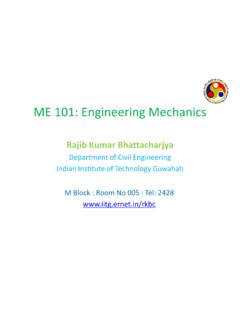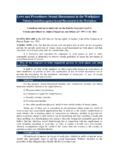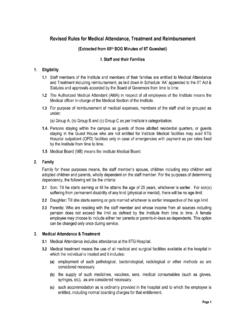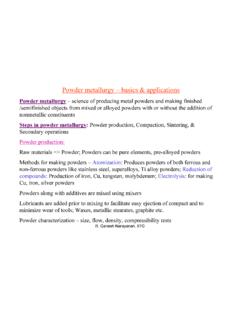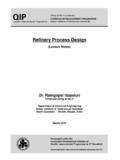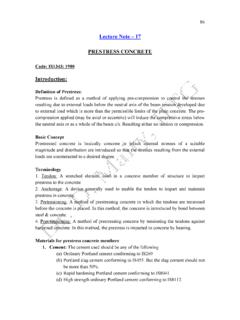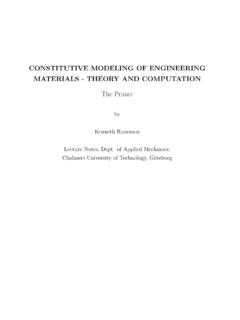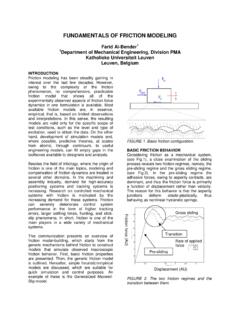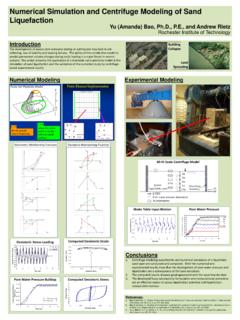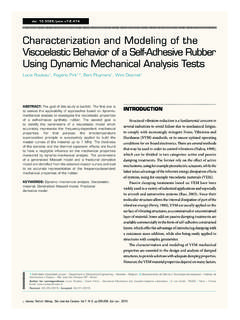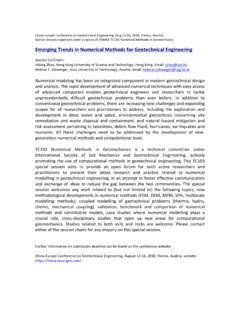Transcription of Modelingand Analysis of Cutting Forces in Micro …
1 5th International & 26th All India Manufacturing Technology, Design and Research Conference (AIMTDR 2014) December 12th 14th, 2014, IIT Guwahati, Assam, India 559-1 Modelingand Analysis of Cutting Forces in Micro End Milling Tej Pratap1*, Karali Patra2 1*, 2 Department of Mechanical Engineering, IIT Patna, Patna, 800013, E-mail: Abstract Micro end milling is one of the widely used processes for producing Micro features/ Micro components in Micro -fluidic systems, biomedical applications, aerospace applications, electronics and many other fields. However in these applications, the Forces generated in the Micro -end milling process can cause vibration and process instability and even cause tool breakage if not minimized.
2 Therefore, an accurate prediction of Cutting Forces in Micro -end milling is essential. In the present study a finite element method based model is proposed for prediction of Cutting Forces in Micro end milling with due consideration of material behaviour, tool edge radius effect and fracture behaviour of the work piece material including friction parameter at tool-chip interface. Micro slots are produced on copper plate using 500 m dia. tungsten carbide Micro -end mill and experimental Cutting Forces are acquired through dynamometer. Model predicted Cutting Forces (feed force and tangential force) are compared with experimental Cutting Forces and are found to be in good agreements.
3 Keywords: Cutting Forces , Micro end milling, Micro -fluidic devices, FEM 1 Introduction Recently the demand of Micro parts in many areas like Micro -fluidics, biomedical, aerospace, electronics, etc., is increasing for enhancing product performance and industrial economic growth (Zamanet al. 2006). To achieve these goals, there is a growing need of a faster, reliable and precise manufacturing approach which can be used for a wide range of materials for different applications (Chaeet al. 2006). The Micro end milling is one of such precise Micro manufacturing approach which shows a great promise in manufacturing of Micro parts and Micro components with three dimensional features, higher aspect ratio and good surface quality.
4 This process is not only faster but also cost effective as compared to other Micro fabrication processes (Wang et al. 2009 and Ducobuet al. 2009). However, the Forces generated in the Micro -end milling process can cause vibration and process instability and even cause tool breakage if not minimized. Therefore, an accurate prediction of Cutting Forces in Micro -end milling is essential. A lot of researches have been performed to analyze the chip formation, mechanics of Cutting Forces and product quality in Micro end milling (Rahmanet al. 2001 andCamaraet al.)
5 2012). However, accurate prediction of Cutting Forces in Micro -end milling is challenging due to size effect, Cutting tool edge radius effect, minimum chip thickness effect, breakage of miniaturized tool, Micro burr formation, etc (Kang etal. 2008 and Camaraet al. 2012). Chaeet al. (2006) surveyed the current trends in mechanical Micro machining research and applications, especially in the field of Micro -milling operations and showed that the chip removal processes, Cutting force modeling , handling and assembly of Micro -partsare the key features in order to provide accuracy and productivity in Micro -scale machining.
6 Dornfeldet al. (2006) also surveyed the process physics, materials and microstructural effects, machine tools, design issues, software and simulation toolsused in mechanical micromachining. Liu et al. (2004) reviewed the mechanics of the rapid growing field of micromachining and discussed modeling techniques such as mechanistic, finite element model, molecular dynamics and multi scale modeling . Mechanistic models were mainly applied to predict Cutting Forces in Micro end milling process. Zamanet al. (2006) have introduced an analytical 3D Cutting force model considering geometry of the tool path for calculation of theoretical chip area at any specific position of the tool.
7 Kang et al. (2007) proposed a mechanistic model of Micro end milling for prediction of Cutting Forces with due consideration of tool-workpiece contact at the flank face. Predicted Cutting Forces were later applied for Analysis of tool condition and surface roughness the Micro -end milling process. Kang et al. (2008)considered tool edge geometry for Micro end milling Cutting force Modelingand found that predicted results were in good agreements with experimental et al. (2012) considered effects of plowing, elastic recovery, effective rake angle and flank face rubbing in a mechanistic model for Micro end milling Cutting Forces .
8 Finite element method (FEM) based modeling techniques have also received wide acceptability for prediction of Cutting Forces in mechanical micromachining with the advancement of recent computational speed. FEM based techniques are good compliments to experimental intensive mechanistic approaches and offer a reasonable insight to the modeling and Analysis of Cutting Forces in Micro End Milling machining process for selection of Cutting parameters (Dornfeldet al. 2006). Lai et al. (2008) applied a FEM model for predicting Cutting Forces using Johnson-Cook constitutive equation strengthening in a Micro scale milling opMicro-scale size effect, edge radiusJohnson-Cook fracture criteria were also consideredWang et al.
9 (2009) and Ducobuperformed 2D numerical simulations of formation in micromilling operation using commercial FEM software ABAQUS/Explicit .Jin and Altintas (2012) predicted the Micro milling Forces with finite element method for brass 260 workpiece. Experimental results obtained from Micro -millingwere compared with simulated resultsand Cutting Forces coefficients werefrom series of FE simulation and used to simulate Micro milling Forces . In the present study a finite element based model is proposed for prediction of Cutting Forces in Micro scale end millingwith due consideration of behaviour, tool edge radius effectbehaviour of the work material including friction parameter in the tool-chip interface.
10 Tprovidesanalysis of the effect of uncut chip thickness (h) on the Cutting areon copper workpiece using500 m tools. Experimental results are verified with proposed modelpredicted results in order to assess the validity of the FEM model. 2 FEM modeling of Micro end An FEM based model of Micro process is developed using ABAQUS/ExpThe dynamic, explicit, adiabatic condition is used to analyse the Cutting process in proposed model (ABAQUS 2008). The considered plastic strainFE model with tool edge radius is shown in FigurFigure 1 FE model of Micro end milling processThe main advantage of FEM based modelable to predict chip formationmechanism,chips, Cutting Forces Analysis , tool temperature and stressesdistribution for different Cutting conditions.
